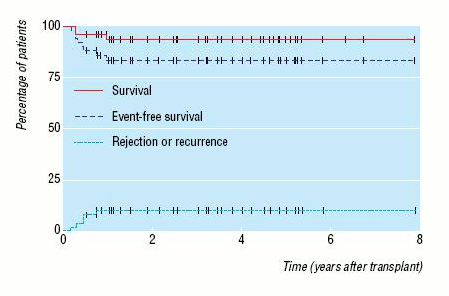Chronic organ damage secondary to sickle cell disease results in many medical complications, although some prophylactic treatments can reduce their incidence.
People with sickle cell disease have a reduced life expectancy. The estimated life expectancy of people with sickle cell disease in the US is more than 20 years shorter than the average for the general population.[2]Centers for Disease Control and Prevention (CDC). Data and statistics on sickle cell disease. May 2024 [internet publication].
https://www.cdc.gov/sickle-cell/data/index.html
[112]Jiao B, Johnson KM, Ramsey SD, et al. Long-term survival with sickle cell disease: a nationwide cohort study of Medicare and Medicaid beneficiaries. Blood Adv. 2023 Jul 11;7(13):3276-83.
https://ashpublications.org/bloodadvances/article/7/13/3276/494890/Long-term-survival-with-sickle-cell-disease-a
http://www.ncbi.nlm.nih.gov/pubmed/36929166?tool=bestpractice.com
One study, using data from patients covered by US public health insurance (from 2008 to 2016), estimated a life expectancy at birth of 52.6 years. Estimates of life expectancy were higher for women than men (55.0 vs 49.3 years) and lower for black people compared with non-black people (52.2 vs 55.1 years).[112]Jiao B, Johnson KM, Ramsey SD, et al. Long-term survival with sickle cell disease: a nationwide cohort study of Medicare and Medicaid beneficiaries. Blood Adv. 2023 Jul 11;7(13):3276-83.
https://ashpublications.org/bloodadvances/article/7/13/3276/494890/Long-term-survival-with-sickle-cell-disease-a
http://www.ncbi.nlm.nih.gov/pubmed/36929166?tool=bestpractice.com
In one 2014 study conducted in the US, median survival for patients with sickle cell anemia (Hb SS) was reported to be 58 years; the comparable figure for those with hemoglobin SC disease was 66 years.[113]Elmariah H, Garrett ME, De Castro LM, et al. Factors associated with survival in a contemporary adult sickle cell disease cohort. Am J Hematol. 2014 May;89(5):530-5.
https://www.doi.org/10.1002/ajh.23683
http://www.ncbi.nlm.nih.gov/pubmed/24478166?tool=bestpractice.com
In Africa, 50% to 90% of children born with sickle cell disease die before they reach their fifth birthday.[114]Grosse SD, Odame I, Atrash HK, et al. Sickle cell disease in Africa: a neglected cause of early childhood mortality. Am J Prev Med. 2011 Dec;41(6 suppl 4):S398-405.
https://www.ajpmonline.org/article/S0749-3797(11)00626-X/fulltext
http://www.ncbi.nlm.nih.gov/pubmed/22099364?tool=bestpractice.com
In the developed world, morbidity and mortality are declining because of improvements in the management of infections and other complications in childhood, new interventions, active health maintenance for adults, and patient counseling. More than 90% of patients of all phenotypes will survive past age 20, and significant numbers are older than 50 years of age.[39]Platt OS, Brambilla DJ, Rosse WF, et al. Mortality in sickle cell disease - life expectancy and risk factors for early death. N Engl J Med. 1994 Jun 9;330(23):1639-44.
http://www.nejm.org/doi/full/10.1056/NEJM199406093302303#t=article
http://www.ncbi.nlm.nih.gov/pubmed/7993409?tool=bestpractice.com
[Figure caption and citation for the preceding image starts]: Survival and recurrence rate for patients with sickle cell disease after bone marrow transplantationFrom: Claster S, Vichinsky EP. BMJ. 2003 Nov 15;327(7424):1151-5 [Citation ends].
